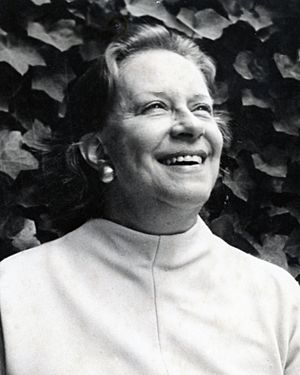Chabuca Granda facts for kids
Quick facts for kids
OSP
Chabuca Granda
|
|
|---|---|

Chabuca Granda in 1971
|
|
| Born |
Maria Isabel Granda Larco
September 3, 1920 Cotabambas Province, Apurímac
|
| Died | March 8, 1983 (aged 62) Miami, Florida, U.S.
|
| Burial place | |
| Occupation |
|
| Years active | 1937–1983 |
| Spouse(s) |
Enrique Demetrio Fuller da Costa
(m. 1942; div. 1952) |
| Children | 3 |
| Parent(s) |
|
| Musical career | |
| Genres |
|
| Instruments | Vocals |
| Labels |
|
| Signature | |
María Isabel Granda Larco (born September 3, 1920 – died March 8, 1983) was a famous Peruvian singer and composer. She was better known as Chabuca Granda. She wrote and sang many Criollo waltzes that often included Afro-Peruvian rhythms.
Chabuca Granda became famous around the world for songs like "La flor de la canela," "José Antonio," "El Puente de los Suspiros," and "Fina estampa." She has inspired many Peruvian artists, including Susana Baca, Eva Ayllón, Gian Marco, and Juan Diego Flórez.
In 2017, her musical works were named a Cultural Heritage of the Nation in Peru. This means they are very important to the country's history and culture. In 2019, the Peruvian government gave her the highest national award, the Order of the Sun, after she had passed away.
Life and Music Career
Chabuca Granda was born on September 3, 1920, in a copper mining area in the Apurímac region of Peru. She started singing when she was 12 years old. She joined the school choir at Colegio Sophianum, an exclusive girls' school in San Isidro, a rich neighborhood in Lima, Peru.
At first, she sang as a soprano, which is a high voice. Later, an operation changed her voice to the deep, rich sound she became known for. She became well-known after her divorce, which was quite unusual for the time in Lima's very traditional society. She found inspiration in Conny Mendez, a Venezuelan composer who sang about her country and nature. Chabuca Granda once said that in Peru, people mostly sang about sad love stories. She believed that popular songs could be performed in different ways by different countries.
Early Songs
In her early career, Chabuca Granda's songs were very lively and colorful. They often described the romantic and beautiful Barranco neighborhood in Lima. This area had grand French houses with impressive entrances and lovely gardens. Some of her most famous songs from this time include "Lima de veras", "La flor de la Canela", "Fina estampa", "Gracia", "José Antonio", and "Zeñó Manué."
She changed the usual rhythm of the waltz in her music. Later, she also changed the way poems were written in songs. Later in her career, she wrote songs dedicated to other artists. These included the Chilean singer Violeta Parra ("Cardo o ceniza") and Javier Heraud, a Peruvian poet who died in 1963.
Towards the end of her career, Chabuca Granda started adding Afro-Peruvian rhythms to her music. Even though Afro-Peruvian music was popular, it wasn't always seen as "high art" because people didn't always value Afro-Peruvian culture as much. Chabuca Granda skillfully mixed these lively rhythms into her work. This made Peruvian popular music even richer and more interesting.
Her Passing
Chabuca Granda passed away from heart problems in a clinic in Fort Lauderdale, United States, in 1983. Her beautiful voice and amazing songs are known far beyond Peru's borders. Her popularity helped introduce the world to the unique and heartfelt style of Peruvian music.
Her Lasting Impact
Chabuca Granda's influence continued long after her death. In 1994, the famous Brazilian musician Caetano Veloso used her song, "Fina estampa", as the title for his album. The next year, her song "Maria Lando," which she wrote with César Calvo, helped the Peruvian singer Susana Baca become known in North America.
Chabuca Granda's song "La Flor de la Canela" has become a special anthem for the city of Lima. It became very popular after the Peruvian group Los Chamas sang it in 1952. Chabuca Granda worked with many talented guitarists throughout her career. Some of these included Oscar Avilés, Lucho Garland, Lucho González, Alvaro Lagos, and Felix Casaverde.
In 2021, the Central Reserve Bank of Perú honored Chabuca Granda. They put her picture on the country's 10 Peruvian sol banknote. This was done to celebrate her amazing legacy and to mark Peru's 200th year of independence.
Discography
- Fina estampa (criollo waltz)
- La flor de la canela (criollo waltz)]
- El puente de los suspiros
- Cardo o ceniza (landó)
- José Antonio (criollo waltz)
- Lima de veras (criolla waltz)
- María Landó (landó)
- Ha de llegar mi Dueño (Tondero
See also
 In Spanish: Chabuca Granda para niños
In Spanish: Chabuca Granda para niños

